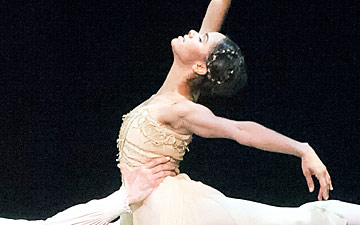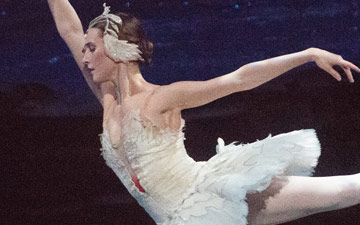
© Darren Thomas, Queensland Performing Arts Centre. (Click image for larger version)
American Ballet Theatre
Swan Lake
New York, Metropolitan Opera House
24 June 2015
www.abt.org
A New Swan
She’s done it, and now everyone can relax. At the Wednesday matinée, Misty Copeland danced her first New York Swan Lake, in a Metropolitan Opera House that was packed to the rafters and bristling with anticipation. (Before today, she had danced the role once before with ABT, in Australia, and once with the Washington Ballet.) There’s no question, Copeland is phenomenon. Her championing of the cause of inclusiveness in an art that is about as racially diverse as the Republican National Convention has brought her legions of new fans, and deservedly so. Her every entrance at the Met was met with a roar of applause. I’ve never seen an audience as vocal, as enthusiastic, or as diverse at any ballet. There were plenty of dance luminaries in the house as well, including Jacques d’Amboise and the Ballet Russe de Monte Carlo ballerina Raven Wilkinson, whose own career was thwarted by racial discrimination. During the curtain calls, Wilkinson and Lauren Anderson, a principal with Houston Ballet in the nineties, came onstage bearing bouquets.
As had already become clear last week after her début in Romeo and Juliet, Copeland has the charisma, acting chops, and technique to carry an evening-length ballet. Any début will also have its points of weakness, and this one was no different. Most noticeably, Copeland seemed to lose her nerve about halfway through the famous fouetté turns in the coda of the third act pas de deux, opting instead to finish with quick single pirouettes from fifth. That’s a bit like an opera singer deciding not to go for the high notes in a famous aria – not the end of the world, artistically speaking, but people notice.
Nonetheless, Copeland gave a touching and complete performance and in some respects a truly remarkable one. Copeland’s Odette, especially, felt lived in; she has already begun to imbue the character with her own take: skittish, passionate. Her dancing in the white act was thoroughly musical, with strong legato phrasing that lent shape and accent to the choreography. She made the most of the unfurling of a leg, sustaining the tension and energy all the way to the tip of the toe; she accentuated the bend and twist of her shoulders and the line of her neck in an arabesque. (Copeland uses her arms, and, especially, her hands, very beautifully.) She took the pas de deux at a glacial pace, extending her movements into space to evoke, in physical terms, Odette’s feelings of emptiness and longing. Her face was almost blank, a mask of loneliness.

© Darren Thomas, Queensland Performing Arts Centre. (Click image for larger version)
Her Odile, in contrast, was more impersonal, and less confidently danced. The ballerina’s technique in the third act is a physical manifestation of the character’s inhuman powers of seduction and invulnerability. Copeland doesn’t yet have the confidence to fully evoke this feeling, though she looked ravishing in some of the part’s iconic poses. Here, her phrasing became less taut, more like a series of effects. She had a disconcerting tendency to stare at the audience rather than at her partner (James Whiteside). But, even here, she added her own touches as when, toward the beginning of the pas de deux, she shook her head very slightly, as if to remind the hapless prince of the creature he had fallen in love with in the forest. It was subtle effect, a hint, perhaps, of what Copland’s Odile may one day become.
This was a striking performance in other ways as well, despite the general listlessness of the production’s first act and the preposterous behavior of Von Rothbart (Aléxandre Hammoudi) in the third. In Kevin McKenzie’s 2000 staging, the evil sorcerer shows up at Siegfried’s birthday party clad in purple tights and thigh-high boots and proceeds to seduce every girl in sight. As one of the princesses bourrées toward him in a trance, he unceremoniously plucks another out of the way, the better to gobble her up. (This moment was met by a wave of laughter.) Nevertheless, there were high points: April Giangeruso’s expansive port de bras and powerful arabesque as one of two “tall” swans at the lakeside – she might make a lovely Odette one day. Devon Teuscher’s relaxed upper body and perfectly-placed turns in the first act pas de trois. Isadora Loyola’s supple back and proud head as one of the Spanish dancers at the ball. And I’ve never seen the Neapolitan dance (all jumps and turns) danced more cleanly or more in sync than it was today, by Sung Woo Han and Joo Won Ahn.
Copeland’s love interest was James Whiteside, strong, dependable and an excellent partner, but a rather generic and not very ardent prince. He tended to disappear into the scenery when not in action. His most dramatic moment may have been the final leap into he lake, which rocketed up and up before beginning its inevitable descent. It was positively Olympic. Calvin Royal stepped into the role of Benno, which he played with a kind of understated sweetness accentuated by his leisurely, buoyant jumps. (There’s not much more for Benno to do.)
Copeland can now breathe a sigh of relief and get back to the business of dancing. She has earned her place center-stage, and it seems more likely than ever that she will be promoted to principal.

















Marina: As you say, a sigh of relief and back to business – just as was said straight after the performance by her Director when a friend danced her first Aurora and Rose Adagio many years ago!
[…] Copeland had her long-awaited New York début in Swan Lake on June 24, with ABT. How did she do? Here’s my review, for […]